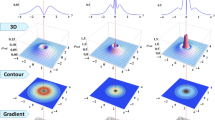Abstract
Context
This article intends to show a new way to setup and solve chemical bonds which can be incorporated into molecules. The new approach is analytical and purely based on simple math and science. We need analytical methods in our molecular theory which can be used to obtain results with our eyes open to the process. The utilization of computer software is fine as long as the user understands what the software is exactly doing. An analytical molecular theory can be utilized in different areas of science including chemistry. It can be also an asset in classrooms to better train our future generations, making them better “thinkers” and ready to tackle the complicated issues in our changing world. This article first introduces a new analytical approach to study chemical bonds and then goes through several examples of chemical bonds to show the applicability of the suggested approach.
Methods
All of the calculations and figures presented in this article are done by the use of Microsoft excel spreadsheet. The presented approach does not need any sophisticated software and/or heavy computations.





Similar content being viewed by others
Data availability (data transparency)
No datasets were generated or analysed during the current study.
Code availability (software application or custom code)
There was no computer software program to be utilized for this article.
References
Zadeh DH, Murray JS, Redfern PC, Politzer P (1991) Computational study of the nitrogen-nitro rotational energy barriers in some aliphatic and alicyclic nitramines. J Phys Chem 95(20):7702–7709. https://doi.org/10.1021/j100173a028
Zadeh DH, Grodzicki M, Seminario JM, Politzer P (1991) Computational study of the concerted gas-phase triple dissociations of 1, 3, 5-triazacyclohexane and its 1, 3, 5-trinitro derivative (RDX). J Phys Chem 95:7699. https://doi.org/10.1021/j100173a027
Zadeh DH, Murray JS, Grodzicki M, Seminario JM, Politzer P (1992) C-H bond dissociation of acetylene: local density functional calculations. Int J Quantum Chem 42:267–272. https://doi.org/10.1002/qua.560420203
Zadeh DH, Murray JS, Grice ME, Politzer P (1993) X-NO2 rotational energy barriers: local density functional calculations. Int J Quantum Chem 45:15–20. https://doi.org/10.1002/qua.560450104
Politzer P, Zadeh DH (1993) Relationship between dissociation energies, force constants, and bond lengths for some N-F and O–F bonds. J Chem Phys 98(9):7659. https://doi.org/10.1063/1.464679
Politzer P, Zadeh DH (1994) Bond-breaking energies for 2, 2’-dichlorodiethyl sulfide (sulfur mustard) in media of different dielectric constants. J Phys Chem 98:1576–1578. https://doi.org/10.1021/j100057a008
Grice ME, Zadeh DH, Politzer P (1994) Calculated structure, heat of formation and decomposition energetics of 1, 3-dinitro-1, 3-diazacyclobutane. J Chem Phys 100(6):4706–4707. https://doi.org/10.1063/1.466257
Zadeh DH, Grice ME, Concha MC, Murray JS, Politzer P (1995) Nonlocal density functional calculation of gas phase heats of formation. J Comput Chem 16(5):654–658. https://doi.org/10.1002/jcc.540160513
Politzer P, Concha MC, Grice ME, Murray JS, Lane P, Zadeh DH (1998) Computational investigation of the structures and relative stabilities of amino/nitro derivatives of ethylene. J Mol Struct (THEOCHEM) 452:75–83. https://homepage.univie.ac.at/mario.barbatti/papers/nitroethylene/politzer_theochem_1998.pdf
Zadeh DH (2017) Electronic structures of elements according to ionization energies. J Mol Model 23(12):357. https://link.springer.com/article/10.1007/s00894-017-3534-2
Murray JS, Zadeh DH, Lane P, Politzer P (2018) The role of ‘Excluded’ electronic charge in noncovalent interactions. Mol Phys. https://www.tandfonline.com/doi/abs/10.1080/00268976.2018.1527044
Clark T, Heβelmann A (2018) The coulombic σ-hole model describes bonding in CX3I…Y- complexes completely. Phys Chem Chemical Physics 35:2018. https://doi.org/10.1039/C8CP03079K
Zadeh DH (2019) Atomic shells according to ionization energies. J Mol Model 25 (8):251. https://link.springer.com/article/10.1007/s00894-019-4112-6
Zadeh DH (2019) A new approach to estimate atomic energies. J Mol Model 25:366. https://doi.org/10.1007/s00894-019-4259-1
Zadeh DH (2021) Molecular theory considering nuclear potential wells. J Mol Model 27:185. https://doi.org/10.1007/s00894-021-04804-2
Zadeh DH (2022) Atomic excited states and the related energy levels. J Mol Model 28:282. https://doi.org/10.1007/s00894-022-05257-x
Zadeh DH (2023) Building a new reasonable atomic theory. J Mol Model 29:268. https://doi.org/10.1007/s00894-023-05673-7
Giancoli DC (1998) Physics (Principles with Applications), 5th edn. Prentice Hall Publisher
Bohr N (1913) The spectra of helium and hydrogen. Nature 92:231–232. https://doi.org/10.1038/092231d0
Bohr N (1913) On the constitution of atoms and molecules, Part I. Phil Mag 26(151):1–24. https://doi.org/10.1080/14786441308634955
Politzer P, Murray JS (2019) A look at bonds and bonding. Struct Chem 30:1153–1157. https://doi.org/10.1007/s11224-019-01364-3
Clark T, Murray JS, Politzer P (2018) A perspective on quantum mechanics and chemical concepts in describing noncovalent interactions. PCCP 20:30076–30082. https://doi.org/10.1039/C8CP06786D
Cheng FH (1997) Static and strength of materials, 2nd edn. GlenCoe (McGraw Hill) Publisher
Milne EA (1927) The total energy of binding of a heavy atom. Proc Camb Philos Soc 23:794. https://doi.org/10.1017/S0305004100015589
Cottrell TL (1958) The strengths of chemical bonds. Butterworths, London. https://doi.org/10.1002/ange.19600721618
Huheey JE, Keiter EA, Keiter RL (1993) Inorganic chemistry: principles of structure and reactivity. HarperCollins College Publishers, New York (ISBN-13: 978-0060429959, ISBN-10: 006042995X)
Lide DR (2007) CRC handbook of chemistry and physics. CRC Press LLC, Boca Raton (ISBN: 0849304881, ISBN13: 9780849304880)
Olmsted JA, Williams GM (2011) Chemistry, 5th edn. Wiley, New York (ISBN-13: 978-0471478119, ISBN-10: 0471478113)
Funding
There was no funding for this research work.
Author information
Authors and Affiliations
Contributions
The article was all done by the submitting author. No other author was involved.
Corresponding author
Ethics declarations
Competing interests
There is no conflict of interest for this research work.
Additional information
Publisher's Note
Springer Nature remains neutral with regard to jurisdictional claims in published maps and institutional affiliations.
⊗ This article is submitted in the honor of Iranian women who are fighting for their freedom under the slogan of “Woman, life, freedom” as well as the other women in the world who are under oppressive forces, fighting for equality or against fanatic, radical religious governments.
Supplementary Information
Below is the link to the electronic supplementary material.
Rights and permissions
Springer Nature or its licensor (e.g. a society or other partner) holds exclusive rights to this article under a publishing agreement with the author(s) or other rightsholder(s); author self-archiving of the accepted manuscript version of this article is solely governed by the terms of such publishing agreement and applicable law.
About this article
Cite this article
Zadeh, D.H. Building a new reasonable molecular theory⊗. J Mol Model 30, 45 (2024). https://doi.org/10.1007/s00894-024-05831-5
Received:
Accepted:
Published:
DOI: https://doi.org/10.1007/s00894-024-05831-5




